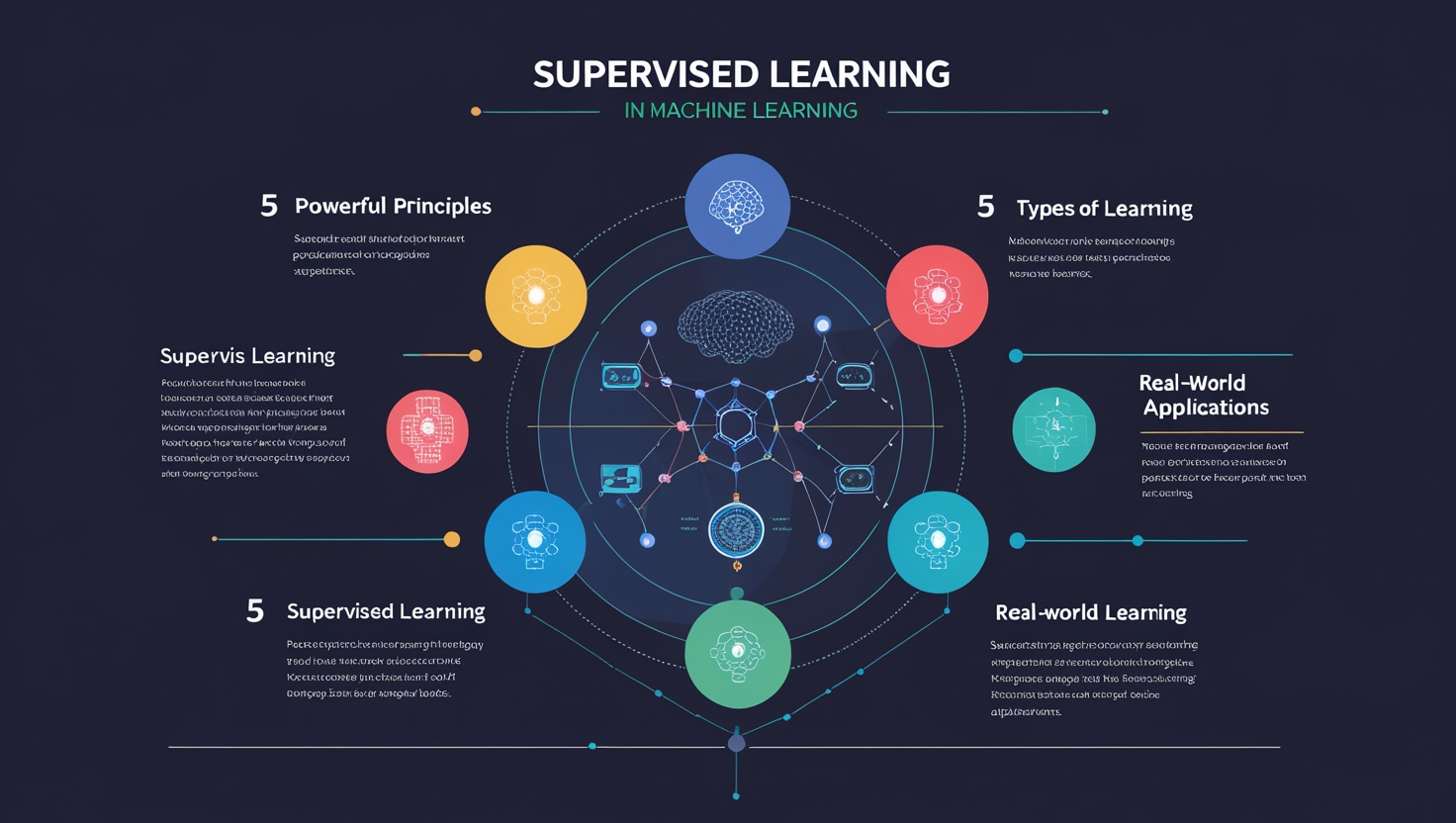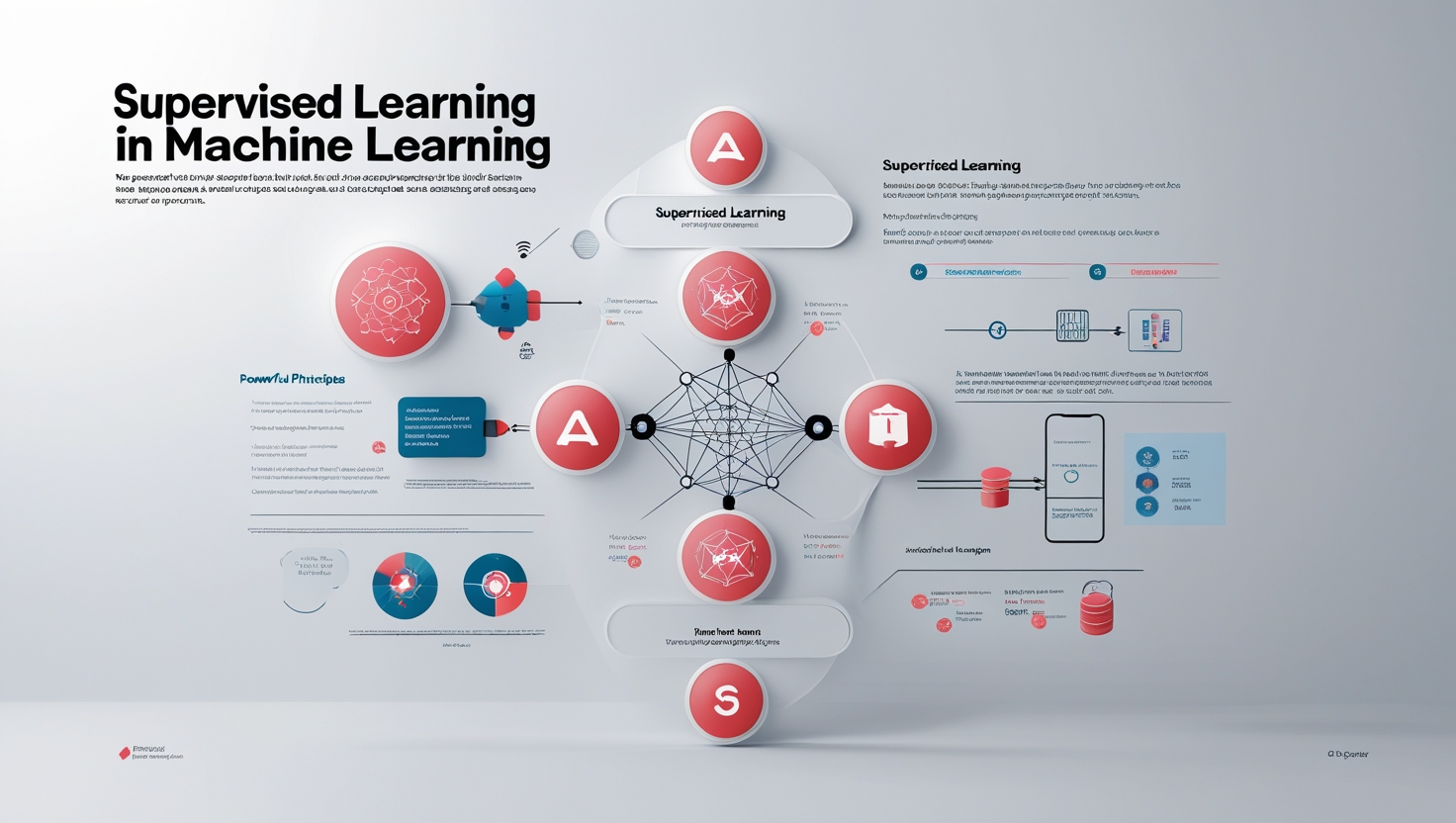Supervised mastering represents a cornerstone of cutting-edge synthetic intelligence, allowing machines to research from categorized datasets and make unique predictions in actual-world eventualities. By training models on enter-output pairs, supervised getting-to-know algorithms uncover hidden styles that pressure choice-making in healthcare, finance, independent systems, and the past. This paradigm’s reliance on curated datasets guarantees excessive, but it introduces challenges like information labeling complexity and overfitting risks. As corporations increasingly adopt system studying to resolve complex problems, information-supervised learning’s mechanisms, applications, and moral implications will become vital for leveraging its capability whilst mitigating boundaries 1 2.

- Introduction to Supervised Learning
- Importance in Machine Learning
- Key Concept: Labeled Data
- How Supervised Learning Works
- The Training Process: Input-Output Mapping
- Role of the Model and Algorithm
- Learning from Labeled Data
- Types of Supervised Learning
- Classification
- Regression
- Key Algorithms in Supervised Learning
- Linear Regression
- Logistic Regression
- Decision Trees
- Support Vector Machines (SVM)
- okay-Nearest Neighbors (ok-NN)
- Neural Networks
- Steps in Supervised Learning
- Data Collection and Labeling
- Data Preprocessing
- Splitting Data: Training and Testing Sets
- Model Training and Evaluation
- Advantages of Supervised Learning
- Accurate Predictions with Labeled Data
- Interpretability of Results
- Wide Applicability
- Challenges in Supervised Learning
- Requirement for Large Labeled Datasets
- Overfitting and Underfitting
- Labeling Difficulties
- Applications of Supervised Learning
- Healthcare: Disease Diagnosis
- Finance: Fraud Detection
- Marketing: Customer Segmentation
- Autonomous Vehicles
- Natural Language Processing (NLP)
- Future of Supervised Learning
- Algorithmic Advances
- Big Data and AI Synergy
- Ethical Considerations
- Conclusion
Introduction to Supervised Learning
The definition of superb getting-to-unsupervised getting-to-knowhow operates as a gadget-getting-to-know method wherein models study mappings between input features and acknowledged output labels using labeled training records. Unlike unsupervised techniques that perceive patterns without steerage, supervised algorithms require explicit examples of correct solutions to set up predictive relationships 1. For example, an electronic mail spam detector trains on hundreds of messages pre-categorized as “spam” or “no longer junk mail, “knowing how to associate precise keywords or metadata with every category. This explicit teaching mechanism allows infashions to generalize from historical information to unseen examples, making supervised gaining knowledge of critical obligations annoying high reliability 2 4.
Importance in Machine Learning
The dependent nature of supervised getting-to-know makes it the favored technique for applications requiring particular outcomes. By leveraging classified datasets, fashions attain higher accuracy in type and regression obligations than unsupervised strategies. For example, scientific diagnosis structures rely on supervised getting to know to expect diseases based totally on labeled affected person statistics, where even minor prediction mistakes should have life-altering effects 1 3. Additionally, supervised gaining knowledge inspires improvements in deep gaining knowledge, allowing complicated architectures like convolutional neural networks to excel in picture popularity and herbal language processing 1 6.
Key Concept: Labeled Data
Labeled records serve as the lifeblood of supervised mastering, which includes input samples paired with corresponding ground-truth outputs. Data scientists manually annotate these datasets, specifying the best solution for each entry—a time-in-depth and luxurious procedure. In self-sustaining car improvement, labeling includes tagging thousands and thousands of video frames with item identities (e.g., pedestrians, traffic lighting) to teach notion structures 1 4. The variety of categorized statistics directly determines overall performance, necessitating rigorous validation protocols to remove biases or inaccuracies that could compromise predictions 6.
How Supervised Learning Works
The Training Process: Input-Output Mapping
Algorithms iteratively alter internal parameters to minimize discrepancies between expected and actual outputs during training. Consider linear regression: the model starts with random coefficients for each input characteristic and incrementally refines them using optimization strategies like gradient descent. Each new release computes prediction mistakes on the training set, adjusting weights to better approximate the goal variable’s conduct2four. For photograph classifiers, neural networks system pixel arrays through layered adjustments, regularly tuning tens of millions of weights to differentiate between classes like cats and puppies1five.
Role of the Model and Algorithm
The choice of rules hinges on problem specifics—category needs extraordinary tactics than regression. Decision trees partition characteristic spaces using hierarchical rules, making them interpretable for credit score scoring structures. In evaluation, aid vector machines (SVMs) assemble hyperplanes to split classes into high-dimensional spaces, excelling in textual content class where statistics sparsity complicates different techniques 3 4. With their deep architectures, neural networks dominate complicated responsibilities like speech reputation by gaining knowledge of hierarchical representations through successive layers 1 6.
Learning from Labeled Data
Supervised models derive know-how from labeled examples, developing statistical representations of enter-output relationships. A stock price predictor might examine historic facts labeled with corresponding marketplace indicators, identifying correlations among hobby rates and fairness values. During inference, the model applies these learned correlations to new, unlabeled information—forecasting expenses primarily based on current monetary signs 2 5. This dependency on labeled facts ensures excessive accuracy; however, it limits applicability in domains wherein annotation proves impractical, such as real-time sensor networks 6.
Types of Supervised Learning

Classification
Classification algorithms categorize inputs into discrete instructions, permitting applications like fraud detection and diagnostic imaging. Logistic regression, notwithstanding its name, estimates class possibilities using a sigmoid feature, making it perfect for binary obligations like tumor malignancy prediction 3 4. Random forests combine forecasts from more than one choice tree, lowering overfitting in multi-elegance situations, which include handwritten digit recognition. Recent advances in transformer architectures have driven class accuracy to close-to-human degrees in NLP duties like sentiment evaluation 1 6.
Regression
Regression fashions expect non-stop numerical consequences, underpinning forecasting systems in meteorology and economics. Polynomial regression extends linear models by introducing better-degree terms and capturing nonlinear relationships in phenomena like pandemic charges. In actual property, gradient-boosted trees integrate weak predictors to estimate housing costs with top-notch precision, thinking about variables from square pictures to neighborhood crime prices 3 5. These fashions face specific demanding situations, especially in extrapolation past schooling information levels—a crucial difficulty for lengthy-term climate projections 6.
Key Algorithms in Supervised Learning
Linear Regression
As the only regression method, linear regression models relationships through immediately-line equations. It assumes linearity between independent variables and the target, making it appropriate for situations like income forecasting in which advertising spending correlates with revenue simultaneously. Coefficients indicate every characteristic’scharacteristic’s effect value, providing interpretability absent in black-field fashions 3 4.
Logistic Regression
Despite its classification focus, logistic regression employs opportunity thresholds to split training. Medical researchers use it to expect disorder chance primarily based on affected person biomarkers, with odds ratios quantifying risk factors. Its computational performance fits actual-time packages like credit card fraud detection, in which milliseconds rely on 3 6.
Decision Trees
Decision trees recursively split statistics primarily based on function thresholds, creating interpretable rule-based systems. Banks deploy them for loan approvals, tracing rejection paths via earnings brackets and credit rankings. However, shallow trees can be afflicted by excessive variance, necessitating ensemble methods like random forests for stability 1 4.
Support Vector Machines (SVM)
SVMs maximize margin separation between training and use kernel tricks to address nonlinear data. Genomic research classifies cancer subtypes by mapping gene expression statistics into higher dimensions in which subtypes become separable. Though computationally extensive, SVMs continue to be famous for small datasets with clean margins 3 6.
okay-Nearest Neighbors (ok-NN)
This example-primarily based learner classifies factors via majority vote among nearest associates. Retailers observe okay-NN for client segmentation, grouping buyers with similar purchase histories. While simple, it struggles with excessively dimensional records in which distance metrics lose meaning—the so-called ” curse of dimensionality “ 1 5.
Neural Networks
Deep neural networks excel in perceptual responsibilities through layered feature extraction. Convolutional layers in picture networks stumble on edges and textures, while recurrent architectures version temporal dependencies in speech reputation. The rise of transformer networks has revolutionized NLP, allowing fashions like BERT to apprehend context through self-interest mechanisms 1 6.
Steps in Supervised Learning
Data Collection and Labeling
Curating excellent datasets needs domain information and extensive assets. Autonomous automobile corporations rent teams of annotators to label LiDAR and camera data, tagging pedestrians, cars, and site visitors’ signs and symptoms throughout numerous weather conditions. Active getting-to-know strategies optimize this technique by prioritizing unsure samples for labeling and decreasing annotation expenses 2 6.
Data Preprocessing
Raw facts undergo normalization, managing missing values, and characteristic engineering. Sensor readings are smoothed in predictive preservation to reduce noise, even as express variables like device type are one-warm encoded. Dimensionality discount strategies like PCA assist in controlling multicollinearity in monetary risk models 3 5.
Splitting Data: Training and Testing Sets
Typical splits allocate 70-eighty% of statistics for education, reserving the remainder for assessment. Time-collection issues require temporal splits to prevent destiny statistics leakage. Cross-validation variants like stratified okay-fold ensure representative elegance distributions in each fold, which is crucial for imbalanced datasets like fraud detection 2 4.
Model Training and Evaluation
Training involves feeding batches via the version and adjusting weights via backpropagation. Evaluation metrics vary using challenge—classification uses accuracy and F1-scores, while regression is based on MAE and R². Hyperparameter tuning via grid optimizes overall performance, balancing bias-variance tradeoffs to save you overfitting 5 6.
Advantages of Supervised Learning
Accurate Predictions with Labeled Data
The express input-output mapping enables particular predictions unequaled through unsupervised methods. Pharmaceutical corporations obtain over 95% accuracy in drug-goal interplay predictions, accelerating discovery pipelines. This reliability makes supervised getting to know crucial for safety-crucial applications like plane fault detection 1 3.
Interpretability of Results
Simpler methods like linear regression provide clear insights into feature significance. Healthcare vendors agree with logistic regression’s interpretability for remedy suggestions, where understanding why a version shows surgical treatment is as vital as the prediction itself. Techniques like SHAP values enlarge interpretability to complicated models, revealing characteristic contributions in neural networks 4 6.
Wide Applicability
From sentiment evaluation to robotic manipulation, supervised gaining knowledge of versatility spans industries. Marketing groups install advice engines skilled in buy histories, while electricity firms forecast calls using weather and consumption records. The paradigm’sparadigm’s adaptability ensures its dominance throughout AI applications 1 5.
Challenges in Supervised Learning
Requirement for Large Labeled Datasets
Labeling charges escalate exponentially with information complexity. Satellite picture annotation for agricultural monitoring requires expert annotators to proscribe dataset sizes. Semi-supervised strategies mitigate this by leveraging small classified datasets alongside abundant unlabeled information, as seen in speech recognition systems 2 6.
Overfitting and Underfitting
Complex models like deep networks memorize education noise, failing on real-global records—a pitfall in medical imaging where mild artifacts distort predictions. Regularization techniques like dropout randomly deactivate neurons at some point in schooling, forcing sturdy characteristic studying. Conversely, oversimplified fashions underfit, as when linear regression fails to capture housing rate nonlinearities 4 5.
Labeling Difficulties
Ambiguous instances challenge even expert annotators. Autonomous systems struggle with labeling part cases like partially obscured pedestrians, requiring consensus protocols amongst more than one annotator. Active getting-to-know frameworks address this by iteratively querying labels for the most uncertain samples and optimizing annotation efforts 6.
Applications of Supervised Learning
Healthcare: Disease Diagnosis
Deep mastering models trained on categorized MRI scans detect tumors with radiologist-stage accuracy. Stanford’s dermatology classifier analyzes pictures of pores and skin lesions, providing preliminary diagnoses in underserved areas. These systems must navigate ethical challenges around diagnostic responsibility and patient privacy 1 6.
Finance: Fraud Detection
Banks deploy gradient-boosted trees to flag suspicious transactions, studying patterns in categorized historical fraud records. Real-time structures manner hundreds of thousands of transactions daily, blocking fraudulent activities within milliseconds while minimizing false positives that inconvenience valid clients 3 5.
Marketing: Customer Segmentation
E-commerce giants use supervised clustering to group buyers by conduct, enabling customized guidelines. By educating beyond purchase labels, fashion expects which merchandise customers will likely purchase next, driving targeted advertising and marketing campaigns 1 4.
Autonomous Vehicles
Perception systems in self-driving motors rely on supervised learning to interpret sensor statistics. Models trained on petabytes of labeled video become aware of visitors’ signs and symptoms, pedestrians, and lane markings, enabling actual-time navigation choices. The challenge lies in coping with uncommon situations not represented in education records, like unique animals crossing roads 1 6.
Natural Language Processing (NLP)
Transformer fashions like GPT-four, educated on categorized text corpora, revolutionized system translation, and content material generation. Supervised best-tuning aligns outputs with human alternatives, permitting applications from prison file analysis to AI-driven customer support chatbots 1 5.
Future of Supervised Learning
Algorithmic Advances
Meta-getting-to-know techniques allow models to conform to new duties with minimum categorized statistics, essential for customized remedies. Quantum system getting to know guarantees exponential speedups in schooling, potentially fixing currently intractable optimization problems 6.
Big Data and AI Synergy
As IoT devices generate zettabytes of classified sensor facts, disbursed gaining knowledge of frameworks like federated studying allows model schooling throughout decentralized gadgets without compromising privateness. This approach powers real-time predictive protection in manufacturing ecosystems 1 5.
Ethical Considerations
Bias in classified datasets perpetuates societal inequalities, as seen in facial reputation structures suffering from various pores and skin tones. Emerging standards mandate algorithmic audits and numerous records collection practices. Differential privacy techniques anonymize schooling information and protect personal identities in healthcare programs 6.
Conclusion
Supervised getting-to-know’s established method to system getting-to-know has catalyzed AI advancements throughout industries, from existence-saving scientific diagnostics to green economic systems. While challenges like facts labeling and model interpretability persist, innovations in semi-supervised learning and ethical AI practices promise to increase their reach. As agencies increasingly depend upon information-pushed selection-making, mastering supervised gaining knowledge of principles and programs remains vital for harnessing AI’s transformative ability responsibly. The field’s future lies in balancing technological prowess with societal accountability, ensuring that this practical equipment gains humanity equitably 1 2 6.
FAQs
1. What is supervised mastering? Supervised learning is a gadget gaining knowledge of methods wherein models discover ways to map inputs to outputs based totally on labeled statistics. It is based on recognized input-output pairs to educate the model on making predictions or classifications. Unlike unsupervised getting to know, supervised gaining knowledge calls for explicit examples of accurate answers to manually the model.
2. What are categorized datasets in supervised learning? Labeled datasets are collections of records in which each input sample is paired with the correct output label. These labels are the ground truth that guides the model’s learning method. For instance, in a clinical prognosis device, categorized information could encompass affected person facts with known diagnoses.
3. What kinds of duties may be done using supervised gaining knowledge? Supervised mastering is mainly used for two types of responsibilities:
- Classification: This entails predicting discrete labels or categories, including determining whether an electronic mail is spam.
- Regression: This involves predicting continuous values and residence expenses primarily based on capabilities like vicinity, size, and age.
4. What are some standard algorithms used in supervised mastering?
- Linear Regression: Used for predicting continuous values based on a linear courting among variables.
- Logistic Regression: A class algorithm used for binary consequences.
- Decision Trees: Used for each type and regression obligations through recursively splitting the information based on feature thresholds.
- Support Vector Machines (SVM): A category set of rules that creates hyperplanes to split lessons in a high-dimensional area.
- K-Nearest Neighbors (K-NN): A simple category set of rules that makes predictions based on the majority label of the nearest facts points.
5. What are the primary demanding situations in supervised mastering?
- Labeling Costs: Labeling records may be time-consuming and expensive, mainly for complicated tasks like clinical picture annotation.
- Overfitting and Underfitting: Overfitting occurs when the version learns the noise in the education records, while underfitting occurs when the model is simply too simplistic to capture the records’ styles.
- Bias in Data: If categorized data is biased, the version will inherit and probably enlarge that bias, leading to unfair or inaccurate predictions.
6. How is supervised mastering implemented in real-global scenarios?
- Healthcare: Supervised learning is utilized in scientific imaging to detect diseases like cancer or to expect affected person results based on historical records.
- Finance: It is used for fraud detection analyzing historical transaction data to become aware of suspicious activities.
- Marketing: Supervised studying enables client segmentation, predicting which clients will likely buy certain products.
- Autonomous Vehicles: Supervised learning is utilized in self-using cars to interpret sensor information and make navigation decisions.
7. What is overfitting, and how can it be averted in supervised studying? Overfitting occurs when a model learns the education facts too correctly, including its noise and beside-the-point information, which causes terrible generalization to new records. Techniques to avoid overfitting include using less complicated models, regularization methods (like L1/L2 regularization), and move-validation.
8. What are a few future trends in supervised mastering?
- Meta-mastering: Algorithms that may teach students how to study and adapt fast to new obligations with minimal labeled records.
- Quantum Machine Learning: The use of quantum computing to speed up education strategies, mainly for big datasets.
- Ethical AI: Efforts to mitigate biases and 9ensure equity in models, specifically whilst operating with sensitive information like health facts or monetary data.
9. How can supervised studying be used ethically?
Ethical problems in supervised getting-to-know embody ensuring that the training information is independent and unfastened from biases that could result in unfair results. Transparency, responsibility, and privacy safety are key regions of attention while deploying supervised getting-to-realize systems, mainly in excessive-stakes domains like healthcare and finance.



